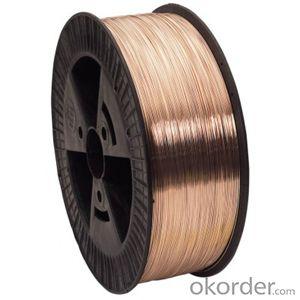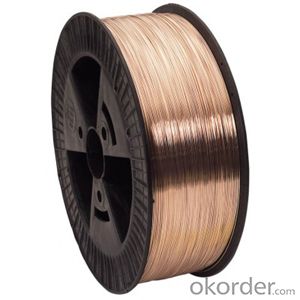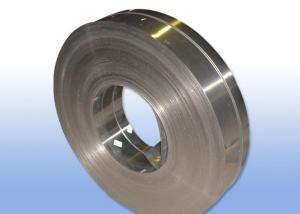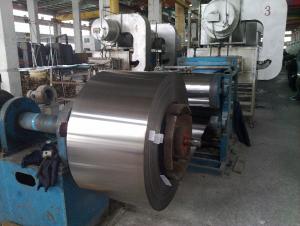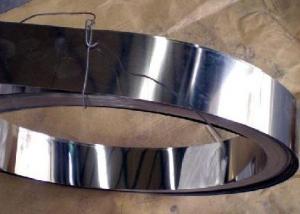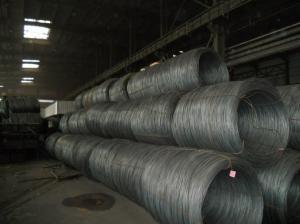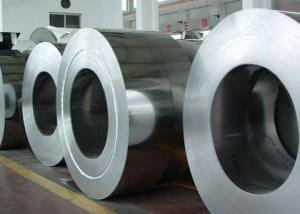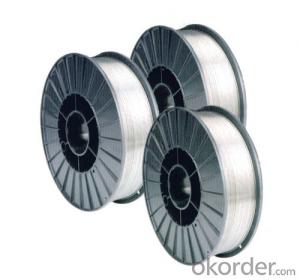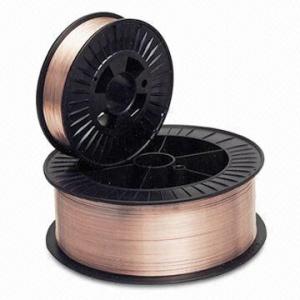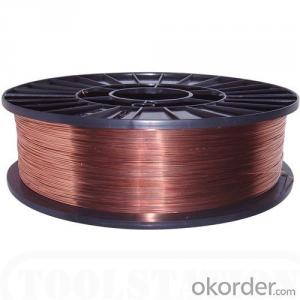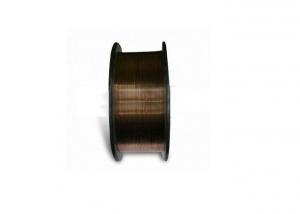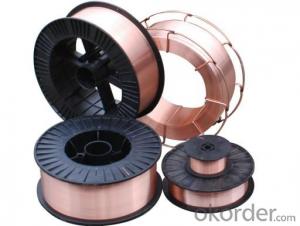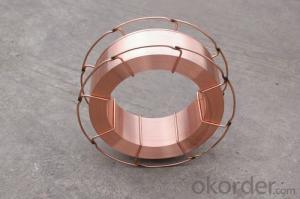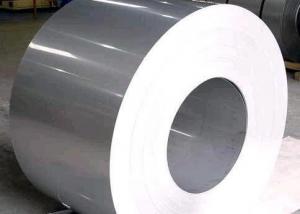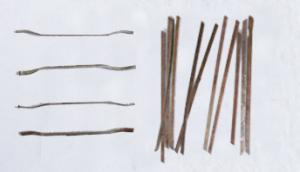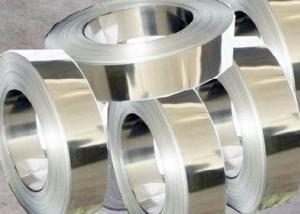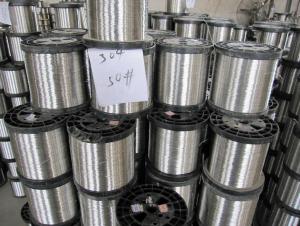welding wire/copper material CO2 gas shielded welding wire ER70S-6
- Loading Port:
- Qingdao
- Payment Terms:
- TT OR LC
- Min Order Qty:
- 10 m.t.
- Supply Capability:
- 1000 m.t./month
OKorder Service Pledge
OKorder Financial Service
You Might Also Like
Specifications
1.copper material CO2 gas shielded welding wire ER70S-6
2.diameter:0.80mm-2.0mm
3.spool weigh:1kg,5kg,15kg,20kg
4.manufacture
Company Profile of copper material CO2 gas shielded welding wire ER70S-6 :
Shandong Luli Steel Co. Ltd, founded in 1993, is a holding company of Luli Group,located in Weifang city, Shandong
province,China. It is a joint steel manufacturer which is combined with sintering, iron smelting, steel-making
and rolled products.Company owns production licenses of deformed bar and round bar and has passed ISO9001
international quality system authentication. Leading products include:
(1)12mm-350mm round bar
(2)6mm-40mm deformed steel bar
(3)0.80mm-2.0mm mig welding wire
Products have been exported to Korea, Japan and Southeast Asia with good reputation.Luli Steel Co., Ltd warmly
welcomes all the customers tovisit factory.If you are interested in our products,pls feel free to contact me.You
could also add me on WHATSAPP or SKYPE to contact in time.Detail contact information as follow:
Marks of copper material CO2 gas shielded welding wire ER70S-6 :
marks | applicable standards/models |
H08A | GB/T 5293 F4A2-H08A |
H08C | GB/T 5293 F4A2-H08A |
H08E | GB/T 5293 F4A2-H08A |
H08MnA | GB/T 5293 F5A2-H08A |
H10Mn2 | GB/T 5293 F4A2-H10Mn2 |
H10MnSi | AWS A5.17 F7A0-EM13K |
H08MnMoA | GB/T 12470 F5A2-H08MnMoA |
H08Mn2MoA | GB/T 12470 F69P2-H08Mn2MoA |
H08Mn2SiA | GB/T 5293 F5A2-H08Mn2SiA |
Chemical composition of copper material CO2 gas shielded welding wire ER70S-6 :
marks | chemical element | |||||||
C | Mn | Si | P | S | Ni | Mo | Ti | |
H08A | 0.07 | 0.40 | 0.021 | 0.014 | 0.011 | 0.008 | ||
H08C | 0.07 | 0.41 | 0.027 | 0.011 | 0.012 | 0.017 | ||
H08E | 0.08 | 0.50 | 0.026 | 0.011 | 0.010 | 0.016 | ||
H08MnA | 0.08 | 0.91 | 0.04 | 0.018 | 0.012 | 0.01 | ||
H10Mn2 | 0.07 | 1.61 | 0.03 | 0.012 | 0.011 | 0.008 | ||
H10MnSi | 0.05 | 0.95 | 0.64 | 0.015 | 0.013 | 0.007 | 0.38 | 0.06 |
H08MnMoA | 0.08 | 1.34 | 0.14 | 0.015 | 0.013 | 0.011 | 0.57 | 0.07 |
H08Mn2MoA | 0.08 | 1.71 | 0.18 | 0.016 | 0.013 | 0.011 | ||
H08Mn2SiA | 0.08 | 1.92 | 0.75 | 0.014 | 0.011 | 0.007 | ||
Mechanical property of copper material CO2 gas shielded welding wire ER70S-6 :
marks | mechanical property | |||
Tensile strength Rm(MPa) | Yield strength Rel or Rp0.2(MPa) | Elongation (%) | Impact energy (J) | |
H08A | 485 | 372 | 29 | 60(-20°C) |
H08C | 555 | 460 | 31 | 87(-20°C) |
H08E | 560 | 470 | 31 | 90(-20°C) |
H08MnA | 501 | 388 | 29 | 68(-20°C) |
H10Mn2 | 512 | 395 | 30 | 69(-20°C) |
H10MnSi | 538 | 427 | 31 | 98(-20°C) |
H08MnMoA | 618 | 495 | 25 | 101(-20°C) |
- Q: Can stainless steel wire hangers be used for hanging heavy coats?
- Yes, stainless steel wire hangers can be used for hanging heavy coats. Stainless steel is a durable and strong material that can support the weight of heavy coats without bending or breaking.
- Q: What are the different types of stainless steel wire springs used in the automotive industry?
- In the automotive industry, various types of stainless steel wire springs are commonly utilized. These springs play a vital role in ensuring the smooth operation of mechanical components by providing support, flexibility, and resilience. The automotive industry frequently employs the following stainless steel wire springs: 1. Compression Springs: The most commonly used spring type in the automotive industry is the compression spring. These springs are designed to withstand compression forces and are commonly found in suspension systems, engine valves, and braking systems. 2. Torsion Springs: Torsion springs generate rotational forces or torque. They are commonly utilized in automotive door handles, hinges, and suspension systems to provide the necessary resistance against rotational movement. 3. Extension Springs: Designed to resist stretching forces, extension springs find their application in automotive components such as seat belts, hood latches, and trunk hinges. They provide the required tension to secure various parts in place. 4. Constant Force Springs: Due to their ability to deliver a consistent force throughout their entire range of motion, constant force springs are widely employed in the automotive industry. These springs can be found in fuel injection systems, throttle control mechanisms, and HVAC systems. 5. Wave Springs: When limited space necessitates a high load capacity, wave springs come into play. They are frequently used in automotive valves, clutch mechanisms, and shock absorbers. 6. Belleville Washers: Also known as conical or disc springs, Belleville washers are utilized in automotive applications requiring a high level of spring force within a confined space. These springs can be found in automotive clutches, transmissions, and braking systems. Each of these stainless steel wire springs possesses unique properties and characteristics that make them suitable for specific automotive applications. The selection of the appropriate spring type depends on factors such as load requirements, space limitations, durability, and cost-effectiveness.
- Q: Can stainless steel wire be used for safety pins?
- Yes, stainless steel wire can be used for safety pins. Stainless steel is a durable and strong material that is resistant to corrosion, making it suitable for various applications, including safety pins. Safety pins are commonly made from stainless steel wire due to its ability to withstand tension and maintain its shape over time. Additionally, stainless steel's smooth surface and resistance to rusting ensure that the safety pins will not easily break or deteriorate with use.
- Q: What are the different forms of stainless steel wire?
- There are several different forms of stainless steel wire, each with its own unique properties and applications. Some of the most common forms include: 1. Round wire: This is the most basic and widely used form of stainless steel wire. It is available in various diameters and is often used for general-purpose applications such as wire mesh, springs, and fasteners. 2. Flat wire: As the name suggests, flat wire is characterized by its flattened shape. It is commonly used in applications that require a wide, thin profile, such as electrical connectors, conveyor belts, and automotive components. 3. Shaped wire: Shaped wire refers to stainless steel wire that has been formed into a specific shape or profile. This can include square, rectangular, or hexagonal wire, among others. Shaped wire is often used in specialized applications such as architectural mesh, filtration systems, and medical devices. 4. Welding wire: Specifically designed for welding applications, welding wire is used to join two or more pieces of stainless steel together. It comes in various forms, such as solid wire, flux-cored wire, or metal-cored wire, depending on the specific welding technique being used. 5. Spring wire: Spring wire is a type of stainless steel wire that has been heat-treated to achieve a desired level of flexibility and springiness. It is commonly used in the manufacturing of springs, clips, and other components that require a high level of elasticity. 6. Fine wire: Fine wire is characterized by its small diameter, typically ranging from 0.001 to 0.040 inches. It is commonly used in applications that require precise, delicate components, such as jewelry, electronics, and medical devices. These are just a few examples of the different forms of stainless steel wire available. The choice of wire form depends on the specific requirements of the application, including strength, flexibility, corrosion resistance, and aesthetic considerations.
- Q: Can stainless steel wire be used for electrical purposes?
- Stainless steel wire is indeed applicable for electrical purposes. Renowned for its remarkable electrical conductivity, resistance to corrosion, and durability, stainless steel proves to be a fitting material for various electrical uses. It finds common utility in electrical wiring, grounding systems, and electrical connectors. Furthermore, stainless steel wire plays a crucial role in the construction of electrical appliances, circuit boards, and electronic devices. Its exceptional thermal properties and ability to withstand extreme temperatures make it a dependable choice for electrical needs. Moreover, the non-magnetic nature of stainless steel wire presents an advantage in situations where minimizing magnetic interference is essential. All in all, stainless steel wire emerges as a versatile and trustworthy option for electrical applications, providing both electrical conductivity and resistance against corrosion.
- Q: How does stainless steel wire perform in corrosive atmospheres?
- Stainless steel wire is highly resistant to corrosion in various atmospheres, including corrosive environments. This is primarily due to the presence of chromium, which forms a protective passive layer on the surface of the wire. This passive layer acts as a barrier, preventing the wire from coming into direct contact with the corrosive elements present in the atmosphere. In corrosive atmospheres, such as those containing high levels of salt, moisture, or chemicals, stainless steel wire demonstrates exceptional performance. It resists oxidation, rusting, and general degradation, ensuring its longevity and reliability in such harsh conditions. This makes stainless steel wire an ideal choice for applications where corrosion resistance is a critical requirement. Moreover, stainless steel wire retains its mechanical strength and integrity even in corrosive atmospheres. It maintains its physical properties, including tensile strength and flexibility, which are essential for its intended applications. This durability ensures that the wire can withstand the corrosive elements without compromising its performance or structural integrity. Overall, stainless steel wire is highly recommended for use in corrosive atmospheres due to its exceptional corrosion resistance, durability, and ability to maintain its mechanical properties. Its performance in such environments makes it a reliable choice for various industries, including marine, chemical processing, oil and gas, and many others.
- Q: Can stainless steel wire be used for springs?
- Yes, stainless steel wire can be used for springs.
- Q: What are the different types of stainless steel wire rope connectors?
- In the market, one can find a variety of stainless steel wire rope connectors, each designed for specific applications and requirements. Some of the most commonly used types are as follows: 1. Wire Rope Clips, also known as wire rope clamps, are utilized to create a loop or eye in the wire rope. They consist of a U-shaped bolt, a saddle, and two nuts that secure the wire rope in place. 2. Swage Fittings are employed to terminate wire rope by compressing it onto the connector using a hydraulic press or swaging tool. These connectors provide a strong and permanent connection, making them suitable for critical applications. 3. Thimbles are inserted into the loop or bend of the wire rope to protect it from abrasion and wear. By providing a smooth surface, they prevent the wire rope from crushing or deforming. 4. Turnbuckles are used to adjust the tension or length of a wire rope. They consist of two threaded eye bolts connected by a body that can be rotated to tighten or loosen the wire rope. 5. Quick Links are fasteners that can be easily opened and closed using a threaded nut. They are commonly used to connect two ends of a wire rope or attach other fittings. 6. Shackles are U-shaped connectors with a pin or bolt that can be inserted through the ends of a wire rope to create a secure connection. They come in various designs, including anchor shackles, chain shackles, and D shackles. 7. Eye Bolts are utilized to create an attachment point for wire ropes, cables, or other hardware. They feature a loop or eye at one end, which can be easily hooked or connected to other fittings. These examples represent only a fraction of the available stainless steel wire rope connectors. The choice of connector depends on factors such as the specific application, load requirements, and desired level of durability and security. It is crucial to select the appropriate connector to ensure a safe and reliable connection for your wire rope.
- Q: How is stainless steel wire annealed?
- Stainless steel wire is annealed through a process called solution annealing. This involves heating the wire to a specific temperature, typically between 1050°C and 1150°C (1922°F and 2102°F), and holding it at that temperature for a predetermined amount of time. The purpose of this heat treatment is to dissolve any carbides or other impurities present in the steel, which helps improve its mechanical properties and corrosion resistance. Once the wire has reached the desired temperature, it is slowly cooled in a controlled manner to prevent the formation of new carbides. This process is known as quenching and is typically done by immersing the wire in a quenching medium, such as water or oil. The rate of cooling is critical to ensure the formation of a fully austenitic structure, which is essential for achieving the desired softness and ductility. After quenching, the wire is usually subjected to a secondary heat treatment called stabilization annealing to further enhance its properties. Stabilization annealing involves heating the wire to a lower temperature, around 850°C to 950°C (1562°F to 1742°F), and holding it at that temperature for a shorter period of time. This process helps to reduce the risk of intergranular corrosion and sensitization, which can occur in stainless steel due to the precipitation of chromium carbides. Overall, the annealing process for stainless steel wire is carefully controlled to achieve the desired softness, ductility, and corrosion resistance. This heat treatment plays a crucial role in ensuring that the wire meets the specific requirements of various applications, such as in the manufacturing of springs, wire mesh, or medical devices.
Send your message to us
welding wire/copper material CO2 gas shielded welding wire ER70S-6
- Loading Port:
- Qingdao
- Payment Terms:
- TT OR LC
- Min Order Qty:
- 10 m.t.
- Supply Capability:
- 1000 m.t./month
OKorder Service Pledge
OKorder Financial Service
Similar products
Hot products
Hot Searches
Related keywords
